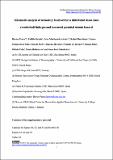Por favor, use este identificador para citar o enlazar a este item:
http://hdl.handle.net/10261/165306COMPARTIR / EXPORTAR:
 SHARE SHARE
 CORE
BASE CORE
BASE
|
|
| Visualizar otros formatos: MARC | Dublin Core | RDF | ORE | MODS | METS | DIDL | DATACITE | |

| Título: | Kinematic analysis of secondary faults within a distributed shear-zone reveals fault linkage and increased seismic hazard |
Autor: | Perea, Héctor ; Gràcia, Eulàlia CSIC ORCID ; Bartolomé, Rafael CSIC ORCID CVN ; Gómez de la Peña, L. CSIC ORCID; Moreno, Ximena CSIC; Díez Tagarró, Susana CSIC ORCID ; Tello-Antón, María Olvido; Gomez-Ballesteros, María; Dañobeitia, Juan José CSIC ORCID | Palabras clave: | Earthquakes Active faults Strike-slip faults Fault linkage Distributed shear zones Alboran Sea Western Mediterranean |
Fecha de publicación: | may-2018 | Editor: | Elsevier | Citación: | Marine Geology 399: 23-33 (2018) | Resumen: | Complex multifault earthquake ruptures involving secondary faults emphasize the necessity to characterize their seismogenic potential better and study their relationship with major faults to improve the seismic hazard assessment of a region. High-resolution geophysical data were interpreted to make a detailed characterization of the Averroes Fault and the North Averroes Faults, which are poorly known secondary right-lateral strike-slip faults located in the central part of the Alboran Sea (western Mediterranean). These faults appear to have evolved since the Pliocene as part of a distributed dextral strike-slip shear zone in response to local strain engendered by the diverging movement of the Carboneras Fault to the north, and the Yusuf and Alboran Ridge faults to the south. In addition, the architecture of these faults suggests that the Averroes Fault may eventually link with the Yusuf fault, thus leading to a higher seismogenic potential. Therefore, these secondary faults represent a hitherto unrecognized seismogenic hazard since they could produce earthquakes up to moment magnitude (M) 7.6. Our results highlight the importance of the role played by secondary faults in a specific kinematic framework. Their reciprocal linkage and their mechanical relationship with the main faults could lead to future complex fault ruptures. This information could improve fault source and earthquake models used in seismic and tsunami hazard assessment in this and similar regions | Descripción: | Perea, Héctor ... et al.-- 11 pages, 8 figures, 2 tables, supplementary data https://doi.org/10.1016/j.margeo.2018.02.002 | Versión del editor: | https://doi.org/10.1016/j.margeo.2018.02.002 | URI: | http://hdl.handle.net/10261/165306 | DOI: | 10.1016/j.margeo.2018.02.002 | Identificadores: | issn: 0025-3227 |
| Aparece en las colecciones: | (UTM) Artículos (ICM) Artículos (IEO) Artículos |
Ficheros en este ítem:
| Fichero | Descripción | Tamaño | Formato | |
|---|---|---|---|---|
| Perea_et_al_2018_postprint.pdf | 1,74 MB | Adobe PDF |  Visualizar/Abrir | |
| Perea_et_al_2018_suppl.pdf | 1,38 MB | Adobe PDF |  Visualizar/Abrir |
CORE Recommender
SCOPUSTM
Citations
14
checked on 20-abr-2024
WEB OF SCIENCETM
Citations
12
checked on 24-feb-2024
Page view(s)
472
checked on 23-abr-2024
Download(s)
377
checked on 23-abr-2024
Google ScholarTM
Check
Altmetric
Altmetric
NOTA: Los ítems de Digital.CSIC están protegidos por copyright, con todos los derechos reservados, a menos que se indique lo contrario.
